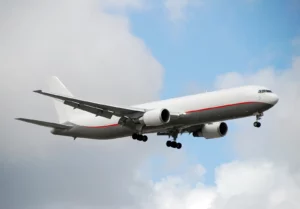
Air freight rates high for the low season – and looking stronger ahead, especially to Europe
Air freight rates enjoyed another solid month in May, with the overall Baltic Air Freight Index (BAI00) calculated by TAC Data edging up +0.9% in the four weeks to 3 June, leaving it ahead by +6.4% over 12 months. The continuing strength of the market is slightly surprising for what is normally a low season of the year – when extra passenger bellyhold capacity is coming on stream over the summer holidays. Market sources cited various reasons for this year’s trend, including continued growth of e-commerce out of China, plus disruption to ocean shipping in the Red Sea and elsewhere pushing more business into air cargo. The index of outbound routes from Hong Kong (BAI30) – still the busiest airport in the world for cargo – was slightly lower by -0.9% over the month, but well ahead by +15.0% YoY. The outbound index from Shanghai (BAI80) gained +3.3% MoM to leave it up a chunky +41.4% YoY. Rates on other lanes out of Asia such as from India and Vietnam also ended the month rising again – particularly on routes to Europe. Out of Europe, by contrast, rates remained somewhat in the doldrums. The index of outbound routes from Frankfurt (BAI20) did have a strong final week of May, boosted by higher rates to Asia, to finish +2.3% MoM – but still down by some -26.0% YoY. Outbound London Heathrow (BAI40) dropped another -12.2% MoM to leave it languishing at -39.8% YoY. From the US, the market was stronger – with outbound Chicago (BAI50) gaining +6.5% MoM to leave it lower by only -17.7% YoY. Industry news at month-end was dominated by a reported US Customs and Border Protection (CPB) crackdown on compliance with rules for its Entry Type 86 programme for small packages entering the country – which allows duty free shipment for items worth $800 or less. The CPB announced in late May it had suspended ‘multiple customs brokers’ for suspected breaches of the rules. CPB said its aim was to tackle the import of illicit substances like fentanyl and other narcotics, counterfeits and other intellectual property rights violations, and goods made with forced labour. Some reports suggested the CPB action had caused considerable disruption for customs brokers and shippers, including delays and cancellations. Sources told TAC, however, that those reports were somewhat overblown – as most big customs brokers already had effective compliance systems in place and were not disrupted. That was supported by evidence cited on Air Cargo News that there had been no noticeable reduction on air freighter activity in late May between North East Asia and North America. Some see the reported crackdown into the US as potentially bad news for the e-commerce business model and leading players such as Temu and Shein. Others, however, point out that those players have already planned ahead – to prepare for tighter rules in the US – and also by expanding successfully into other markets around the world. Indeed, the other significant talking point in late May was the strength of rates from Asia into Europe – which some sources suggested was not yet fully reflected in the data so far on average rates achieved. Looking ahead, sources were also suggesting current patterns could presage a very strong peak season – which traditionally reaches its zenith during the runup to the Thanksgiving holiday in the US and on until Christmas and New Year in Europe. Apparently, a lot of available capacity for block space agreements (BSAs) has already been signed up for the peak season period. If so, that may mean spot rates could really spike later in the year. The current strength of the market will already be boosting the outlook for profitability among airline carriers – with cargo rates holding so steady while jet fuel prices were falling another -7.7% in the month to 31 May, according to Platt’s data. The strength of the market into Europe also chimes with macroeconomic patterns. Since the Covid pandemic, growth in the world economy has been led primarily by the US – which enjoyed a robust recovery led by its top tech companies. The US economy does now seem to be slowing down – but very gradually into what some anticipate will be the softest of soft landings. Europe, by contrast, has had to wrestle with the impact of the war in Ukraine – which led first to a massive increase in gas and electricity prices, and then inflation more generally. With European consumers reacting by cutting back on spending and saving more, that had the effect of strangling growth – both in the Eurozone and the UK. Now, however, with inflation increasingly back under control, there seems room for quicker and steeper interest rate cuts in Europe – particularly in the Eurozone – than in the US. As pointed out before, given their higher saving levels, European consumers also have plenty of firepower to increase spending. All of which is starting to raise expectations that economic growth in Europe will finally start to crank up – with the UK following a similar pattern despite core inflation there remaining a little more sticky. The strength of air cargo markets into Europe are perhaps starting to reflect that stronger market – as well as some diversion of ocean shipping traffic due to disruption in the Red Sea.









